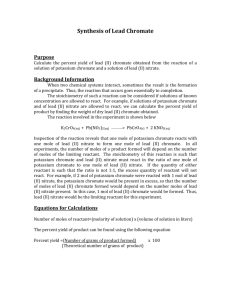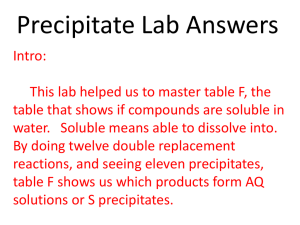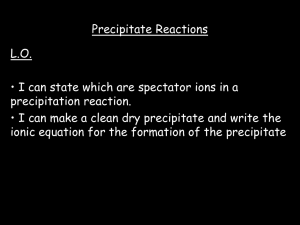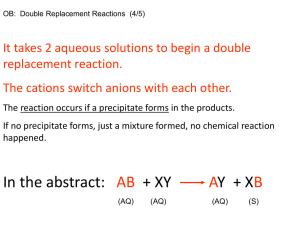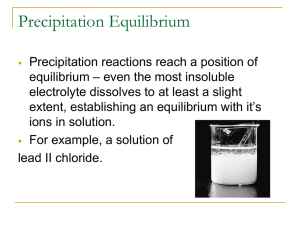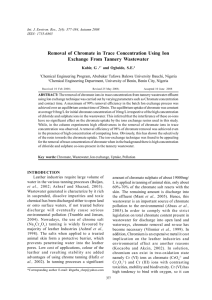Expt 8_2 IonicEquation
advertisement
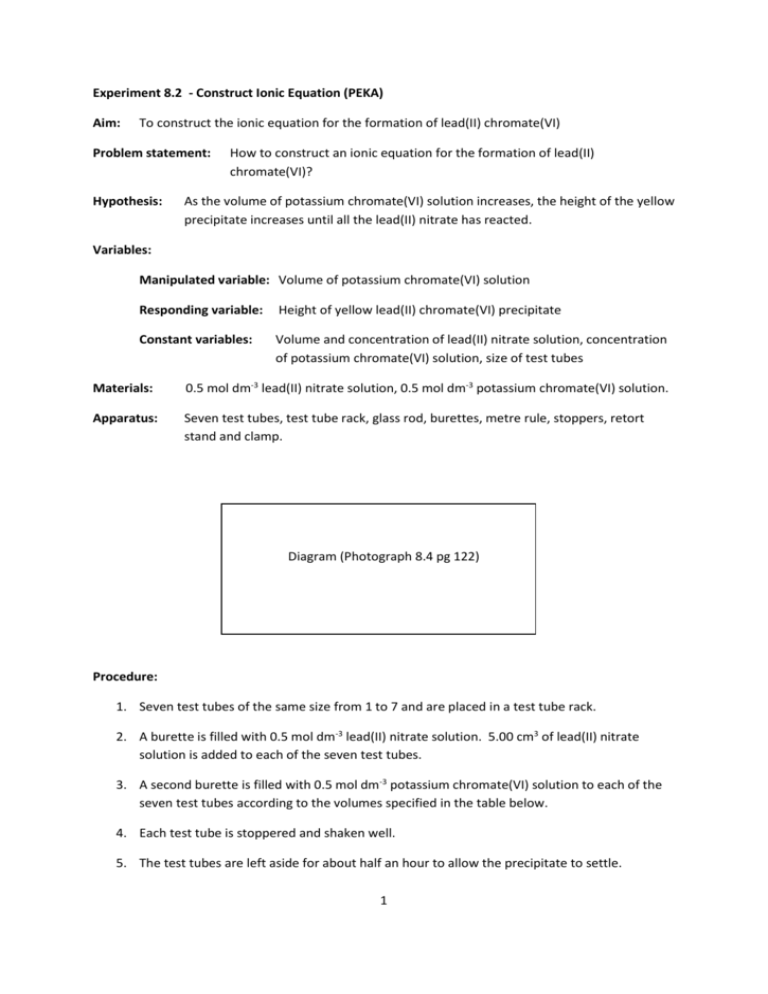
Experiment 8.2 - Construct Ionic Equation (PEKA) Aim: To construct the ionic equation for the formation of lead(II) chromate(VI) Problem statement: Hypothesis: How to construct an ionic equation for the formation of lead(II) chromate(VI)? As the volume of potassium chromate(VI) solution increases, the height of the yellow precipitate increases until all the lead(II) nitrate has reacted. Variables: Manipulated variable: Volume of potassium chromate(VI) solution Responding variable: Height of yellow lead(II) chromate(VI) precipitate Constant variables: Volume and concentration of lead(II) nitrate solution, concentration of potassium chromate(VI) solution, size of test tubes Materials: 0.5 mol dm-3 lead(II) nitrate solution, 0.5 mol dm-3 potassium chromate(VI) solution. Apparatus: Seven test tubes, test tube rack, glass rod, burettes, metre rule, stoppers, retort stand and clamp. Diagram (Photograph 8.4 pg 122) Procedure: 1. Seven test tubes of the same size from 1 to 7 and are placed in a test tube rack. 2. A burette is filled with 0.5 mol dm-3 lead(II) nitrate solution. 5.00 cm3 of lead(II) nitrate solution is added to each of the seven test tubes. 3. A second burette is filled with 0.5 mol dm-3 potassium chromate(VI) solution to each of the seven test tubes according to the volumes specified in the table below. 4. Each test tube is stoppered and shaken well. 5. The test tubes are left aside for about half an hour to allow the precipitate to settle. 1 6. The height of precipitate in each test tube is measured. The colour of the solution above the precipitate in each test tube is noted. 7. The colour of the solution above the precipitate in each test tube is noted. 8. All readings and observations are recorded in the table below. 9. A graph of precipitate height against volume of potassium chromate(VI) solution added is plotted. Data and Observation: Test tube 1 2 3 4 5 6 7 Volume of 0.5 mol dm-3 lead(II) nitrate solution (cm3) 5.00 5.00 5.00 5.00 5.00 5.00 5.00 Volume of 0.5 mol dm-3 potassium chromate(VI) solution (cm3) 1.00 2.00 3.00 4.00 5.00 6.00 7.00 Height of precipitate (cm) 0.60 1.20 1.80 2.40 3.00 3.00 3.00 Colour of solution above precipitate colourless colourless colourless colourless colourless yellow yellow Interpreting data: 1. Number of moles of lead(II) ions in each of the test tubes = MV 0.5 mol dm-3 x 5.00 dm3 = 0.0025 mol 1000 2. From the graph, the volume of potassium chromate(VI) solution that reacted completely with 5.00 cm3 of lead(II) nitrate is 5.00 cm3. The maximum precipitate height achieved is 3.00 cm. This means that all Pb2+ ions from lead(II) nitrate solution have completely reacted with all CrO42- ions from potassium chromate(VI) solution to form yellow precipitate of lead(II) chromate(VI) in test tube 5. 3. The number of moles of potassium chromate that reacted completely with 5.00 cm3 of lead(II) nitrate = MV 0.5 mol dm-3 x 5.00 dm3 = 0.0025 mol 1000 2 4. The number of moles of chromate ions that will combine with 1 mole of lead(II) ions: Simplest mole ratio of Pb2+ ions : CrO42- ions = 0.0025 : 0.0025 = 1 : 1 Therefore, I mole of chromate ion will combine with 1 mole of lead(II) ions. 5. Ionic equation for the formation of lead(II) chromate(VI): Pb2+(aq) + CrO42-(aq) → PbCrO4(s) Discussion: 1. The volume of lead(II) nitrate solution is kept constant because we need to fix the amount of one of the reactant. 2. The reason for adding different volumes of potassium chromate(VI) to each test tube is because we need to determine the number of moles of chromate ions that will react completely with 1 mole of lead(II) ions. 3. The aqueous solution above the precipitate in test tubes 1 to 5 is colourless; test tubes 6 and 7 is yellow. 4. The height of precipitate formed increase and then become constant because more and more lead(II) chromate is formed due to the increasing amount of potassium chromate(VI) added to the test tubes until all lead(II) ions have completely react with chromate(VI) ions. 5. If different sizes of test tubes are used in the experiment, it will affect the measurement of the height of precipitate formed. Conclusion: The ionic equation for the formation of lead(II) chromate(VI) can be obtained form a precipitation reaction. The hypothesis can be accepted. 3
